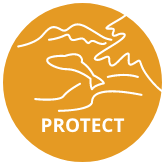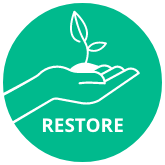

Watershed CPR
The Rivershed Society of BC has adapted a strategy of Watershed CPR – Connect, Protect, Restore—as a path to creating a resilient Fraser Watershed by promoting and using nature-based solutions.
What is a resilient watershed? A resilient watershed has the capacity to retain and improve community, economic, and ecosystem health, even during major disturbances such as climate change.
Click each circle to learn how we define a “resilient Fraser.”
 |  |  | ||||
| What does it mean? | Connecting people with and within the Fraser Watershed. | Advocating for the legal protection of land within the Fraser Watershed. | Restoring damaged habitat within the Fraser Watershed. | |||
| Why? | Connecting people to each other and their watershed allows communities to better understand the issues facing the Fraser and create a unified effort to build a resilient watershed. | Large parts of the Fraser remain intact, but are threatened by climate change and unsustainable growth. Protection will support the continued resilience of these critical habitats and foster Indigenous sovereignty. | Restoration of damaged areas is critically important to combatting climate change and building ecosystem resilience. | |||
| What does this look like? | Connecting a movement through education, awareness, and advocacy campaigns. Over the next decade, the Watershed Movement will help protect and restore salmon and wildlife habitat in each of the Fraser's 34 riversheds, transforming it into a resilient watershed with salmon, people, and economies flourishing. Developing strategic collaborations throughout the Fraser Watershed to create a unified voice for a resilient Fraser. Building and fostering respectful relationships with First Nations, who have been stewards of the lands within the Fraser River since time immemorial and continue that significant role today. | Elevating and supporting regional campaigns that are working to protect key salmon and wildlife habitat to achieve the protection necessary for a resilient Fraser Watershed. Fostering Indigenous sovereignty and stewardship of the land by prioritizing Indigenous Protected and Conserved Areas (IPCA) and Indigenous-led land management strategies, which also result in higher biodiversity protection. Supporting land trusts, conservation funds, private land conservation easements, and parks and protected area systems that preserve habitat throughout the Watershed. | Elevating, supporting, and leading efforts that assist in the recovery and regeneration of ecosystems and habitats within the Fraser Watershed. Prioritizing restoration efforts that foster Indigenous sovereignty and stewardship, increase biodiversity, and include a protection plan to ensure long-term resilience. Leading the Foodlands Corridor Restoration Program, which works to restore pieces of private land adjacent to waterways within the Fraser Watershed. | |||
| Rivershed’s Goals | Rivershed's mission is to connect a movement to protect and restore the Fraser's 34 riversheds. | Rivershed's goal is to see 30% of the Fraser Watershed protected by 2030. | Rivershed's goal is to see 2.4% of the Fraser Watershed restored by 2030. |



